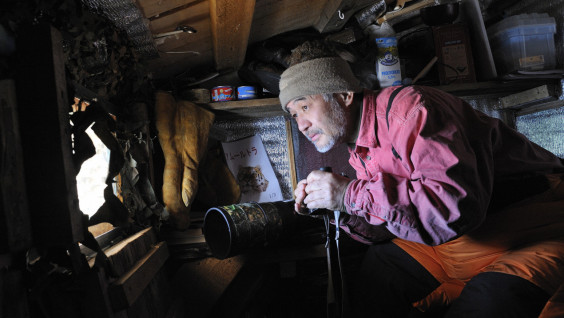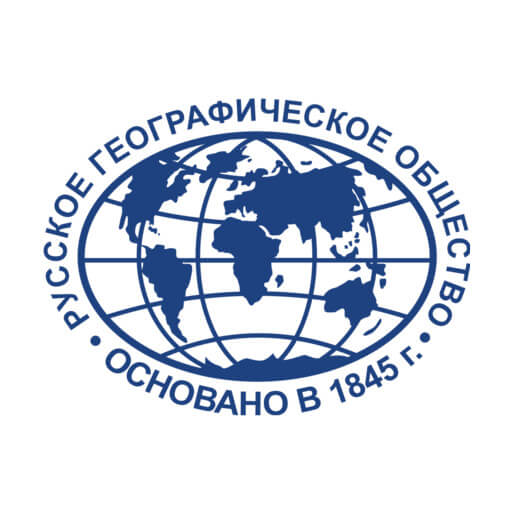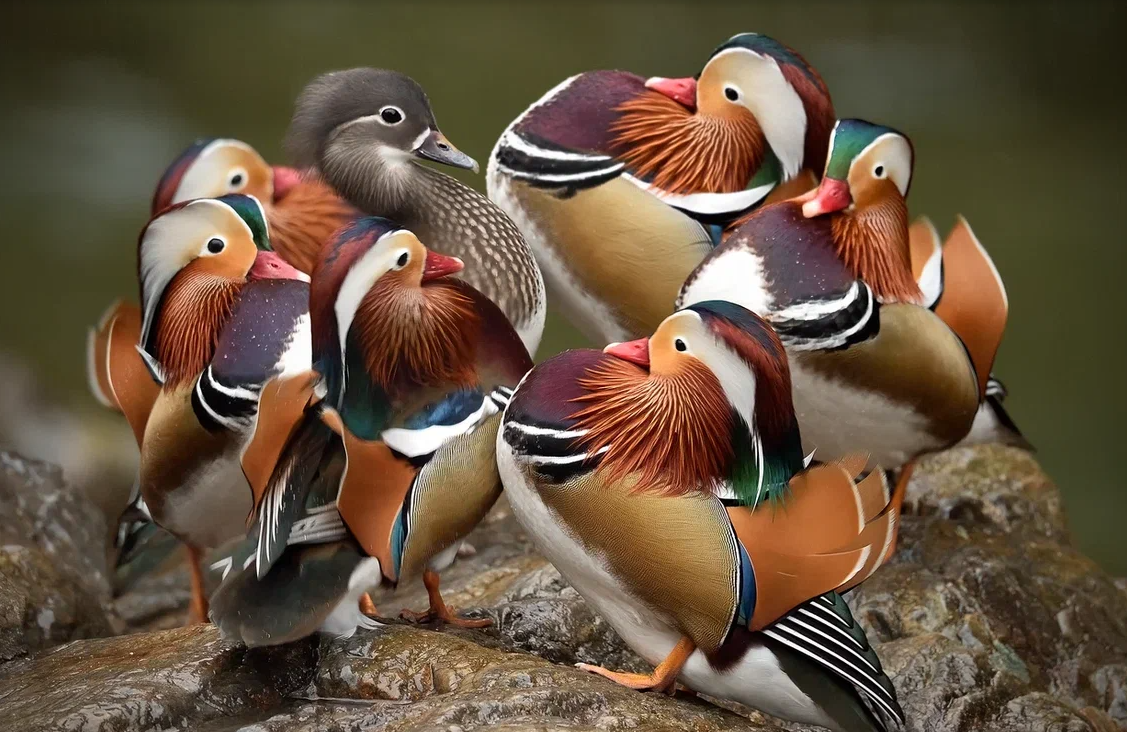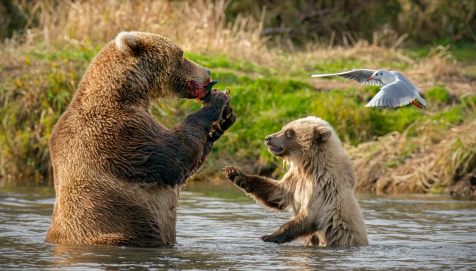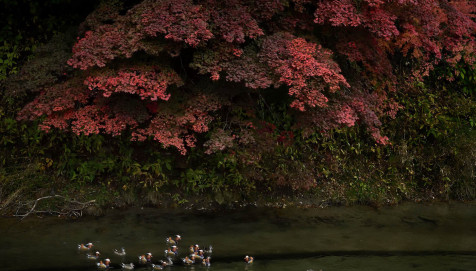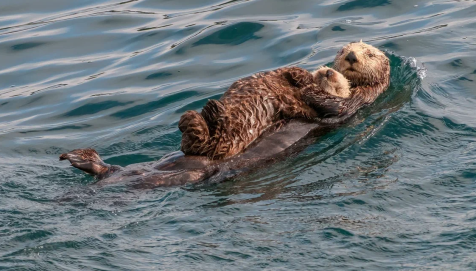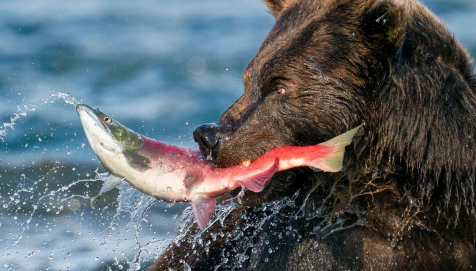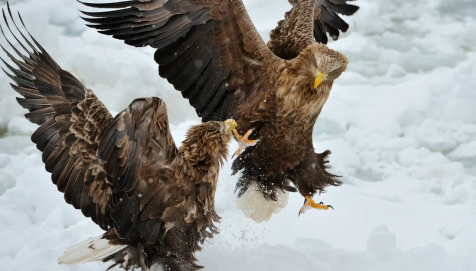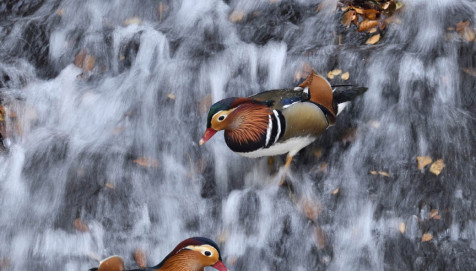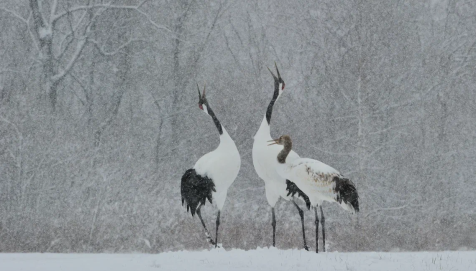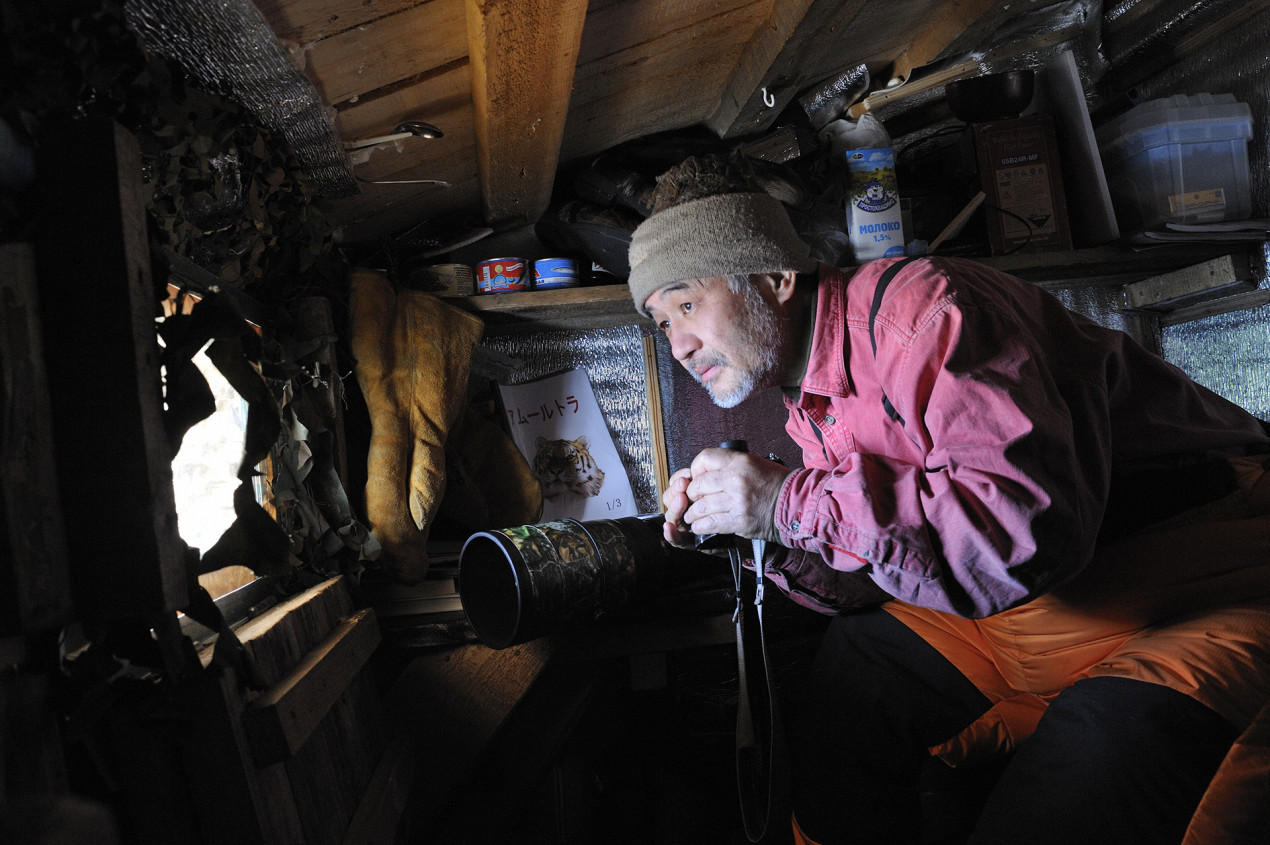
Toshiji Fukuda at the cape of Opasnaya Bay. Photo courtesy of Toshiji Fukuda
His last name translates to «field of happiness». Everyone interprets the concept in their own way. And Japanese Toshiji Fukuda is happy when he is in the wild and is capturing its rare inhabitants on camera. For several decades now, he has been traveling between his homeland and remote parts of the Russian Far East. He became the first photographer from the Land of the Rising Sun, who managed to capture the Amur tiger. He was the first foreign photographer to photograph the exit from the den of a polar bear with cubs on Wrangel Island. He studied to be a diver and worked underwater on the Kuril Islands. His photographs become a scientific document and a call for nature conservation. In 2025, Toshiji Fukuda’s photography project «Nature Without Borders» was awarded the prestigious International Crystal Compass Award.
Toshiji Fukuda is a member of the Japan Professional Photographers Society, the Society of Scientific Photography of Japan, the St. Petersburg Club of Wildlife Photographers, the Union of Wildlife Photographers, an honorary member of the National Scientific Center of Marine Biology of the Far Eastern Branch of the Russian Academy of Sciences and the Russian Academy of Arts. He is the organizer and participant of many exhibitions in Japan, Great Britain, and Russia. The master’s photographs are published in BBC Wildlife Magazine, National Geographic, and other publications. Fukuda is the author of more than ten photobooks about nature: «The Kingdom of Polar Bear», «Siberian Wilderness», «In Pursuit of the Ussuri Tiger», etc.
The Butterfly Effect
Toshiji Fukuda grew up in the city of Utsunomiya in Central Japan. It is surrounded by forests and ponds filled with the sounds of owls, crickets, and dragonflies. It was then that he had an idea: «Let’s leave behind the evidence that all this existed». From the age of 18, he began to photograph endangered species. He came to Russia for the first time in June 1990. A fishing tour for foreigners took place in the Khabarovsk Territory.
«I will never forget the shock I felt when I checked into a hotel on the banks of the Amur River. An owl flew out of a tree above the hotel, and there was also a butterfly called Limenitis populi. Owls of this species raised chicks in my garden. That was decades ago. You can’t find them in Utsunomiya today, just like those poplar admiral butterflies,» the photographer recalls.
As the days of the fishing tour passed, Toshiji Fukuda’s desire to capture the fauna that had disappeared in Japan and remained in Russia intensified. While his fellow fishermen were engrossed in catching Sakhalin taimen and cherry trout, he walked alone along the taiga animal trails, looking for fresh tracks of brown bears and foxes. He wanted to see what he had loved since childhood over and over again. This feeling captured him so much that Fukuda began to work with the Russian Academy of Sciences and the specialists at the reserve. For more than 30 years now, he has been coming to the Far East every year and spending up to six months there with a camera in his hands.
«The Russian Far East is a nesting place for waterfowl such as swans, geese, ducks, as well as small birds such as Bohemian waxwing, thrushes, buntings, and bramblings, which enrich the winter nature of Japan. My favorite white-tailed eagle, which breeds only in the northern part of the Russian Far East, also lives here,» says Toshiji Fukuda.
74 Days in Ambush
In the life of every wildlife photographer, there is a picture that cost a lot. For Toshiji Fukuda, this was the shot of an Amur tiger. It was his dream, which he had been working towards for many years. The hunt for the «invisible creature» took place in the Lazovsky Nature Reserve in Southern Primorye, which covers an area of 1,200 square kilometers. In Tokyo, more than a million people live on such territory, and in nature this territory can only be inhabited by two or three male tigers.
«I remember asking the local inspectors how often they had seen this wildcat themselves. Roman replied that he had only heard a roar twice in 10 years. Anatoly has heard the roar four times in 12 years and seen it twice. Vitaly was an inspector at the reserve for 20 years, he patrolled it every day. During this time, he saw the Amur tiger seven times. I made camera traps. I left the cameras for weeks. I only managed to get four pictures in two years. And then I decided to set up an ambush,» the photographer recalls.
A hole was dug at the cape of Opasnaya Bay and a tiny 1.5 by 2.5 m encampment was built, disguised as a hill. They made an electric fence inside in case the tiger decided to get to know the photographer better.
«It was like a prison cell where I sentenced myself to spend the whole winter. My 'crime’ was the desire to take a photo of the Amur tiger in the wild. I was already 63 years old. I’ve been waiting for him for 50 days. I remember waking up to a noise. Together with my partner Vladimir Medvedev, we slowly opened the window. An Amur tiger stood in the morning sun. Magnificent. Perfect. Three clicks of the shutter and he disappeared like a ghost. I waited another 24 days for his return. In vain. But the main thing is that I saw him. The Amur tiger is the spirit of the taiga. And for the sake of one meeting with him, it was worth spending months in an earthen pit,» says Toshiji Fukuda.
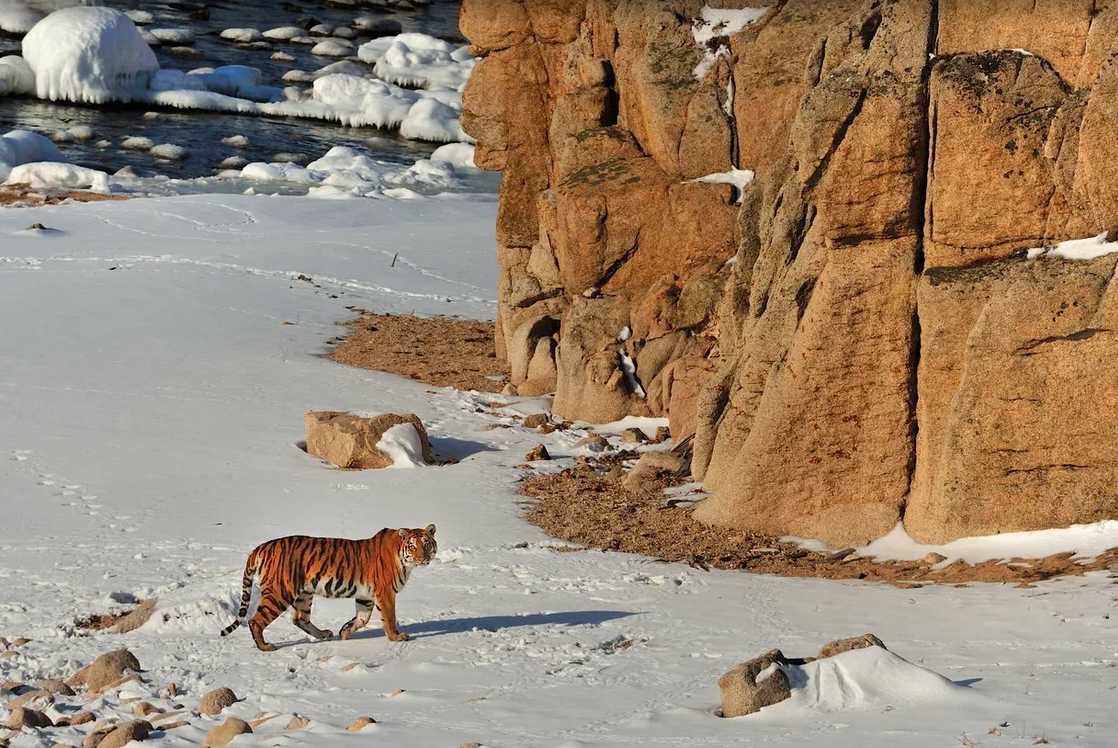
Amur tiger. Lazovsky Nature Reserve (2012). Photo: Toshiji Fukuda
In 2013, at the largest Wildlife Photographer of the Year competition, Toshiji Fukuda received the Durrell Award in the Endangered Species category at the Natural History Museum in London for one of these shots. He often clarifies that photography is not a business for him. And the cash prize for winning that competition was given by Toshiji Fukuda to the World Wildlife Fund of Russia to preserve this predator.
«I’m not hiding»
One of the most common issues of photographing animals is to not make them afraid, flee in panic, or become aggressive. And if there simply would not have been a chance when photographing the «invisible creature», Amur tiger, when it comes to other animals and birds Toshiji Fukuda developed his own technique: to not hide, but to engage in a dialogue. That is why his work is appreciated not only for its beauty, but also for its scientific accuracy and ethics. He lifts the camera smoothly, makes eye contact, and the animal doesn’t perceive him as a threat. That’s how he spent three and a half hours next to a bear and her cubs.
«I calm animals with body language. I look into their eyes and show them that I won’t hurt them. I was talking kindly to the bear, and she was calmly walking next to me all the time while I was taking these pictures,» Toshiji Fukuda shared the secret.
The value of Fukuda’s shots also lies in the fact that he does not retouch the pictures, but conveys the genuine, unpolished reality. The Japanese photographer is also famous for his ability to capture the fleeting wonders of nature. One of his most famous shots is of a bear cub standing on its hind legs under a rainbow. This photo was taken in Kamchatka, where Fukuda was working on a series of pictures of brown bears. He watched the animals for a long time, not interfering, waiting for rare moments.
The rain had just stopped that day, and the sun was breaking through the clouds. The little bear, as if sensing the strangeness of the moment, froze on a hillock and raised his paw, as if greeting an old acquaintance. A rainbow appeared in the background, and Fukuda managed to take a few shots. The photo has become a symbol of the vulnerable beauty of the wild, which a person can observe without disturbing its peace.
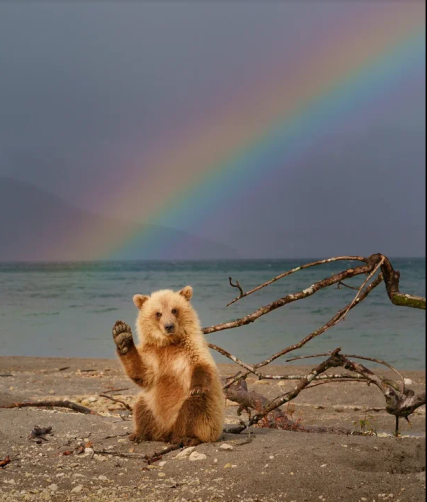
Kamchatka (2019). Photo: Toshiji Fukuda
Nature without borders
Fukuda’s photographs show Amur leopards, brown bears, polar bears of Wrangel Island, and sea lions of Iony Island in the Sea of Okhotsk. He drew attention to another connection between the two countries: knowledge of Russian nature helps to understand the nature of Japan. His work was admired by visitors to the New Gallery of the Royal Society for the Conservation of Tigers in London. Exhibitions were also held on the Primorsky Stage of the Mariinsky Theater in Vladivostok, at the State Zoological Museum of the Russian Academy of Sciences, and at the Headquarters of the Russian Geographical Society in St. Petersburg. In 2015, a mesmerizing portrait of a mandarin duck won him a victory in the Backyards photography contest of the Nature’s Best Backyards magazine. In Japan, there is special attitude towards these birds, and it would seem that it is there that they should be photographed. But to take pictures of their lives, Toshiji Fukuda went to Vladivostok, because here ducks allow people to get close to them.
«The most beautiful duck and very important. In Japan, they say, 'Buddha used to be a mandarin duck! ’» explains the photographer.
As part of the promotion and popularization of the achievements and creative projects of the Crystal Compass laureates, the organizing committee of the national award organized the exhibition «Nature Without Borders» in Moscow, in the White Hall of the Russian Academy of Arts (RAA). There were more than 50 images of the wildlife of Japan, Eastern Siberia, and the Arctic. The day before, Toshiji Fukuda had been awarded the title of the Honorary Member of the RAA.
«I reached Wrangel Island in the north, the border with North Korea in the south, the Commander Islands in the east, and the Lena River in the west. And in different regions, I have captured the life of wild animals. I am fascinated by the nature of Russia, for me it is like a journey through time thousands of years ago to my homeland,» emphasized Toshiji Fukuda.
The Crystal Compass
In 2025, Toshiji Fukuda became the winner of the geographical International Crystal Compass Award in the category «Photography» with the project «Nature without Borders». An exciting ceremony under the slogan «Planet of Heroes» was held on May 29, at the Moscow International House of Music. It was dedicated to the 180th anniversary of the Russian Geographical Society and was supported by the Presidential Foundation for Cultural Initiatives. The statuette made of crystal and silver was presented to the winner by the Special Envoy of the Russian Foreign Ministry for Russian-American Humanitarian Relations, actor, director Steven Seagal.
«I am in the company of really amazing people with whom I am friends, and with those with whom I would like to be friends. Thanks to you, the heroes of this award, this world is becoming one. This is really important. What people do here, why they are here. That’s why for me this grand ceremony is not just words, but a gathering of amazing minds and amazing people,» said Steven Seagal.
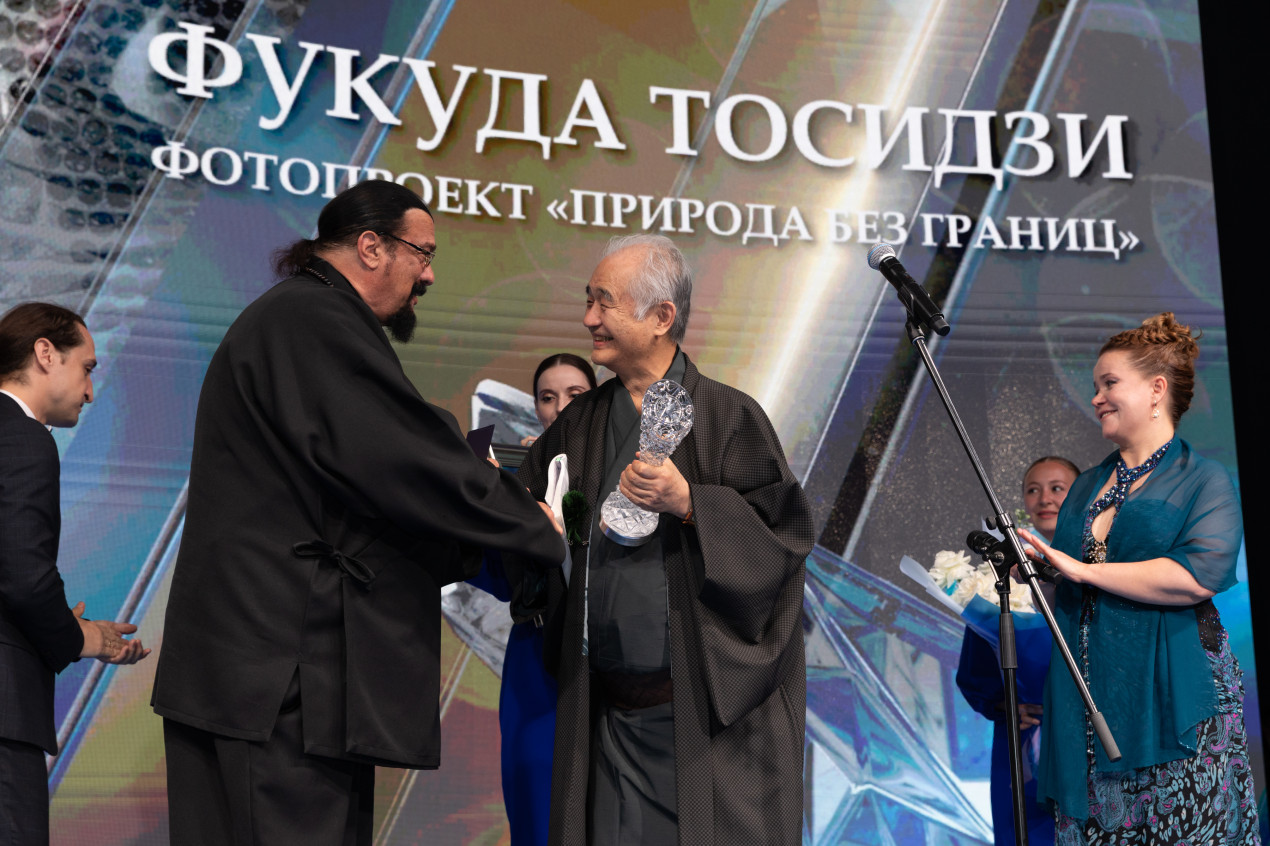
Steven Seagal and Toshiji Fukuda. Photo: Feliks Geller, Anna Zinovieva
«I am lucky to be in a kind, sincere, and generous cooperation with Russian friends and acquaintances, as well as with the world’s leading scientists and specialists. I would be happy to continue investing all my efforts in the further development of this photo project, which was created with the assistance of people from Russia, and became part of the foundation of friendship between Japan and Russia,» said Toshiji Fukuda in response.
The National Crystal Compass Award is awarded annually for outstanding achievements and scientific research in the field of geography, ecology, and related sciences, or for major contributions to the preservation of natural, historical, and cultural heritage, and the development of society. It is one of the main and most prestigious geographical awards in the world. Over the past 13 years, almost 5,000 projects from 51 countries have been nominated for the award. Almost 3.2 million people expressed their preferences in the special «Public Recognition» category, where the laureates are determined by online voting. This year’s award is supported by the Presidential Foundation for Cultural Initiatives and is dedicated to the 180th anniversary of the RGS.
Elena Ryzhkova
